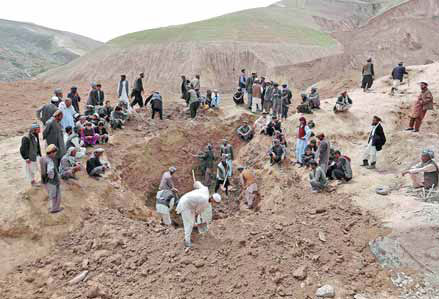Landslide aid work shifts to homeless
Afghan rescuers and volunteers armed with shovels and little more than their bare hands dug through the mud on Saturday after a massive landslide swept through a village the day before, turning it into an earthen tomb holding hundreds of bodies, officials said.
The government and aid groups rushed to bring food, water and shelter to the survivors as the government tried to ascertain just how many people were killed in the latest natural disaster to hit a country already reeling from nearly three decades of war.
Officials gave up hope on Saturday of finding any survivors from a landslide in the remote northeast, with the number killed or missing put at between a few hundred and as many as 2,700.
The United Nations said the focus now was on helping more than 4,000 displaced people.
International organizations and Afghan officials said at least 300 mud brick homes were buried on Friday, but precise information on the number killed was hard to come by in the impoverished Badakhshan province bordering Tajikistan.
Fears of a new landslide complicated rescue efforts, as homes and residents were buried under meters of mud.
"That will be their cemetery," said Mohammad Karim Khalili, one of the country's two vice-presidents, who visited the scene on Saturday. "It is not possible to bring out any bodies."
Though figures on the death toll varied, residents knew the toll that the tragedy had taken on their own families.
From atop a muddy hill, Begam Nesar pointed to the torrent of earth below that had wiped out much of her village. "Thirteen of my family members are under the mud," including her mother, father, brothers, sisters and children, she said. She had been visiting relatives at a nearby village when the disaster struck.
Part of the confusion regarding the number of people who have been buried arose from the fact that no one knew how many people were home when the landslide struck.
At least 255 people were confirmed dead, Khalili said. Most of those were people who had rushed to the scene to help after a previous, smaller landslide. When the bigger landslide hit, those people along with roughly 300 homes were wiped out. But since no one knows how many people were in those homes, counting the dead is difficult, Khalili said.
Mohammad Aslam Seyas, deputy director of the Natural Disaster Management Authority, said fears of new landslides had slowed the operation.
The ground on a hill overlooking the village was soaked from recent heavy rainfalls that officials believe triggered the slide. About 1 km away, the government and aid groups set up tents for those who had been displaced.
Few had time to flee before the mud wall caved in.
Sunatullah, a local farmer, was outside when he felt the earth start to move. He ran to his house, grabbed his wife and children and then ran to the top of a nearby hill. Minutes later, he said, part of the hill collapsed.
"The houses were just covered in mud," he said, adding that he had lost 10 members of his extended family, his house and his livestock.
Authorities distributed food and water to survivors, said Abdullah Homayun Dehqan, the head of Badakhshan province's National Disaster Department.
But residents were worried about more natural disasters to come.
|
Afghan villagers dig for victims at the site of a landslide in Badakhshan province on Sunday. Mohammad Ismail / Reuters |
(China Daily 05/05/2014 page10)













